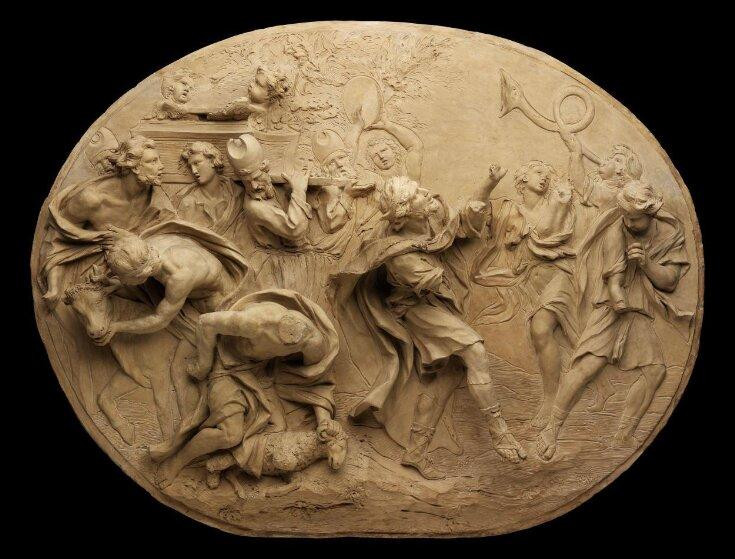Christian culture is rich with traditional sayings, many drawing inspiration from Psalms, liturgies, and biblical narratives. These sayings often reflect cultural values and expectations. One such saying, “He danced without leaving room for Jesus,” or “She is dancing without leaving room for Jesus,” is a common expression, yet you won’t find it explicitly stated in the Bible. This raises the question: where did this popular phrase, centered around the idea of Danced Without Leaving Room For Jesus Meaning, originate, and what does it truly convey?
Understanding the “Leave Room for Jesus” Concept
When someone remarks, “They danced without leaving room for Jesus,” they’re suggesting that a couple was dancing in very close proximity, leaving minimal space between them. Within certain Christian circles, there’s an unspoken expectation for men and women to maintain enough physical distance to theoretically accommodate another person between them. This imagined “extra person” is none other than Jesus. The underlying belief is that inappropriate behavior is less likely to occur under the perceived supervision of Jesus.
Purity Culture and Physical Boundaries
The concept of “leave room for Jesus” is deeply rooted in the value of physical purity within the church. Purity encompasses various aspects, but the Bible particularly emphasizes sexual purity as a way to honor God with our bodies. The Apostle Paul, in 1 Corinthians 6:18-20, powerfully articulates this: “Flee from sexual immorality. Every other sin a person commits is outside the body, but the sexually immoral person sins against his own body. Or do you not know that your body is a temple of the Holy Spirit within you, whom you have from God? You are not your own, for you were bought with a price. So glorify God in your body.”
While interpretations of sexual immorality vary, traditional Christian teachings generally consider sex designed for marriage. Premarital sex is often regarded as sinful. Consequently, excessive physical closeness is viewed as a potential precursor to inappropriate touching and ultimately, sexual immorality. This is why the “leave room for Jesus” adage extends beyond just dance partners. Variations of the phrase are commonly heard in various contexts:
- Leave room for Jesus.
- Save room for Jesus.
- Make room for Jesus.
Regardless of the setting, the underlying message remains consistent. Whether it’s sitting on a couch, sharing a restaurant booth, or being alone at home, the principle of “leave room for Jesus” is meant to apply.
Beyond Dancing: Broader Applications
The “leave room for Jesus” principle isn’t solely about physical distance during dancing or dating. It’s a broader metaphor for maintaining boundaries and avoiding temptation in all aspects of life. It’s about consciously choosing to create space – physical, mental, and spiritual – for God in our interactions and relationships.
The Intention Behind the Saying
The primary intention behind the “leave room for Jesus” saying is preventative. By creating physical space, individuals aim to minimize temptation and maintain purity. The idea is that if there’s room for another person, especially a divine presence, between a couple, the likelihood of premature intimacy decreases. This metaphorical chaperone, empowered by faith, encourages couples to consider their actions and intentions before escalating physical intimacy.
However, it’s crucial to acknowledge that not all physical closeness inherently leads to sin, and not all affectionate touch is inherently wrong. Dancing itself, in many contexts, can be a harmless and enjoyable social activity. Yet, for Christians deeply committed to purity, dancing, particularly close dancing, can be perceived as a potentially risky activity.
 Couple slow dancing closely in a dimly lit room
Couple slow dancing closely in a dimly lit room
Tracing the Origins of “Danced Without Leaving Room for Jesus”
Dancing, as an art form, can be inherently sensual. In the animal kingdom, dance often serves as a courtship ritual. Humans, too, can use dance for seduction, but it also exists as a form of innocent social interaction. This duality creates ambiguity, leading some Christians to approach dancing with caution. The phrase “leave room for Jesus” likely emerged as a way to articulate and reinforce healthy boundaries for believers navigating these complexities.
While a definitive historical record of the phrase’s exact origin is elusive, its emergence is likely linked to broader cultural shifts concerning morality and sexuality. The concept of purity and maintaining boundaries is prevalent across various religions, making it unsurprising that a saying like this would develop to communicate purity expectations within Christian culture.
Cultural and Historical Context
It’s plausible that the phrase gained traction during one of the sexual revolutions of the 20th century. Periods like the Roaring Twenties, the 1960s, and the 1990s witnessed increasing social acceptance of promiscuity. In response, conservative Christian communities sought to protect their youth from what they perceived as the moral decline reflected in dance halls and evolving societal views on human sexuality.
Purity Movements and the Phrase’s Emergence
These cultural shifts spurred the rise of numerous purity programs, including purity pledges, purity rings, and purity balls, particularly in the 1990s. Coining phrases like “leave room for Jesus” was likely a strategic element within these movements, designed to be a memorable and easily disseminated reminder of purity standards, especially concerning danced without leaving room for jesus meaning.
“Leave Room for Jesus” in Modern Times
Today, while you may still hear “They danced without leaving room for Jesus” or “Save room for Jesus,” the context has often shifted. It’s less frequently used as a direct admonishment for purity and more commonly employed satirically or humorously.
Satirical and Humorous Usage
The phrase has permeated popular culture, appearing in unexpected places. For example, it was featured in an episode of the popular ABC show Black-ish, and it has become a recurring theme in online memes, often used to playfully comment on overly close physical proximity. The movie Footloose, while not explicitly using the phrase, thematically explores the tension between dance and conservative Christian values, reflecting similar concerns about dance leading to moral corruption.
Adaptation for Social Distancing
Interestingly, the phrase experienced a resurgence in a completely different context during the COVID-19 pandemic. Churches and other organizations cheekily adopted “leave room for Jesus” on posters and social media campaigns to encourage social distancing, reminding people to maintain physical space to slow the spread of the virus. This demonstrates the phrase’s adaptability and continued cultural resonance.
Evolving Meaning: Making Space for Jesus in Life
Beyond its literal and humorous applications, “make space for Jesus” is also evolving into a broader spiritual reminder. In today’s fast-paced and distraction-filled world, the phrase serves as a call to intentionally create room for Jesus’s influence in daily life. It encourages believers to prioritize their relationship with God amidst busy schedules and competing demands.
Dancing in the Bible: A Deeper Look
Dancing holds a significant place in the Bible, particularly within Hebrew culture. It was a multifaceted practice, used for worship, praise, celebration of festivals, and commemoration of victories. Exploring biblical examples of dancing provides a richer understanding of its diverse meanings and contexts.
Positive Examples of Dance in Scripture
The Bible presents numerous instances of dance as an expression of joy, gratitude, and worship towards God:
-
Miriam’s Dance of Praise: After the miraculous parting of the Red Sea, Moses’s sister, Miriam, led the women in song and dance to celebrate God’s deliverance: “Then Miriam the prophetess, Aaron’s sister, took a tambourine in her hand, and all the women followed her, with tambourines and dancing” (Exodus 15:20).
-
Women’s Dance for David: Upon David’s triumphant return after defeating Goliath, women from Israelite cities came out to greet King Saul and David with singing and dancing: “As they came home, when David returned from striking down the Philistine, the women came out of all the cities of Israel, singing and dancing, to meet King Saul, with tambourines, with songs of joy, and with musical instruments” (1 Samuel 18:6).
 King David dancing with joy, playing a harp, biblical illustration
King David dancing with joy, playing a harp, biblical illustration
-
David’s Dance Before the Ark: King David famously danced with unrestrained joy before the Lord as the Ark of the Covenant was brought to Jerusalem: “And David danced before the Lord with all his might. And David was wearing a linen ephod” (2 Samuel 6:14). His enthusiastic dance, however, was met with disapproval from his wife, Michal, highlighting differing perspectives on appropriate expressions of worship.
-
Prophetic Encouragement to Dance: The prophet Jeremiah spoke of dance as a form of praise and rejoicing in God’s restoration: “Again I will build you, and you shall be built, O virgin Israel! Again you shall adorn yourself with tambourines and shall go forth in the dance of those who make merry” (Jeremiah 31:4). He further prophesied, “Then shall the young women rejoice in the dance, and the young men and old shall be merry. I will turn their mourning into joy; I will comfort them, and give them gladness for sorrow” (Jeremiah 31:13).
-
Ecclesiastes and Psalms on Dance: The book of Ecclesiastes acknowledges dancing as a natural part of life: “a time to weep, and a time to laugh; a time to mourn, and a time to dance” (Ecclesiastes 3:4). Psalms also encourages dance as a form of praise: “Let them praise his name with dancing; let them sing praises to him with tambourine and lyre!” (Psalm 149:3) and “Praise him with tambourine and dance; praise him with strings and pipe!” (Psalm 150:4).
Negative Examples: Sinful Dancing and Idolatry
While the Bible portrays dance positively in many instances, it also presents negative examples, primarily associated with idolatry and sinful behavior:
- Golden Calf Incident: After the Israelites left Egypt, they engaged in idolatrous worship, including dancing around a golden calf: “As soon as he came near the camp and saw the calf and the dancing, Moses’ anger burned hot, and he threw the tablets out of his hands and broke them at the foot of the mountain” (Exodus 32:19). This dance was a form of rebellion against God and a descent into pagan worship.
 People dancing around a golden calf, idol worship, biblical scene
People dancing around a golden calf, idol worship, biblical scene
-
Prophets of Baal on Mount Carmel: The prophets of Baal danced wildly around their altar in a futile attempt to summon their god to consume their offering in a contest against Elijah: “And they took the bull that was given them, and they prepared it and called upon the name of Baal from morning until noon, saying, “O Baal, answer us!” But there was no voice, and no one answered. And they limped around the altar that they had made” (1 Kings 18:26). This dance, driven by desperation and false worship, stood in stark contrast to true worship of God.
-
Herod’s Daughter and John the Baptist: The story of Herod and Herodias’s daughter illustrates how dance can be manipulated for malicious purposes. Herodias’s daughter danced before King Herod and his guests, pleasing him so much that he rashly promised to grant her any request. Prompted by her mother, she requested the head of John the Baptist: “For when Herodias’s daughter came in and danced, she pleased Herod and his guests. And the king said to the girl, “Ask me for whatever you wish, and I will give it to you”… And she went out and said to her mother, “What should I ask for?” And she said, “The head of John the Baptist.” And she came in immediately with haste to the king and asked, saying, “I want you to give me at once the head of John the Baptist on a platter”” (Mark 6:22-25). This tragic event highlights the potential for dance to be used in morally corrupt contexts.
These contrasting examples demonstrate that dance itself is not inherently good or evil. Its spiritual significance depends on its context, motivation, and purpose. Discernment is essential for understanding how dance fits into a Christian’s life and whether it glorifies or offends God.
Did Jesus Dance?
Jesus serves as the ultimate model for Christian living. Looking to his example is crucial for understanding how to live a life that honors God. So, did Jesus, the embodiment of Christian virtue, dance?
The Bible offers no direct account of Jesus dancing or not dancing. However, considering Jesus’s Jewish identity and the cultural context of his time, it’s highly probable that he participated in celebratory dances common in Jewish culture. Jesus attended a wedding in Cana, where he performed his first miracle (John 2). Jewish weddings were joyous, extended celebrations, and dance was an integral part of these festivities. It’s reasonable to assume Jesus joined in the customary dances.
Furthermore, Jesus made a casual reference to dancing in one of his teachings: “To what then shall I compare the people of this generation, and what are they like? They are like children sitting in the marketplace and calling to one another, “We piped to you, and you did not dance; we wailed, and you did not weep”’” (Luke 7:31–32). In this analogy, Jesus uses dancing as a natural and expected response to joyful music, suggesting its normalcy in his cultural understanding.
 A person dancing freely with arms raised, silhouetted against a bright light, symbolizing joy and worship
A person dancing freely with arms raised, silhouetted against a bright light, symbolizing joy and worship
Dance for Christ
While Jesus likely participated in dance forms different from modern styles, particularly considering the historical Jewish customs that often discouraged mixed-gender dancing, his example points to a crucial principle: there is a way to dance that honors God.
Paul’s instruction in 1 Corinthians 10:31 provides a valuable guideline for Christians: “So, whether you eat or drink, or whatever you do, do all to the glory of God.” Unmarried men and women can engage in dance without compromising sexual purity. “Leaving room for Jesus” doesn’t need to be interpreted as a literal measurement of physical distance between dance partners. Instead, it’s about cultivating a mindset of saving space for Jesus in every area of life.
Ultimately, the question of whether to dance, and how to dance, is a matter of personal conviction guided by the Holy Spirit. If our intention is to honor God in all we do, including our social interactions and expressions of joy, then we can confidently “dance for Christ,” ensuring that our actions align with our faith and values. The true meaning of “leaving room for Jesus” extends far beyond the dance floor, urging us to make space for Him in our hearts and lives, in every step we take.

